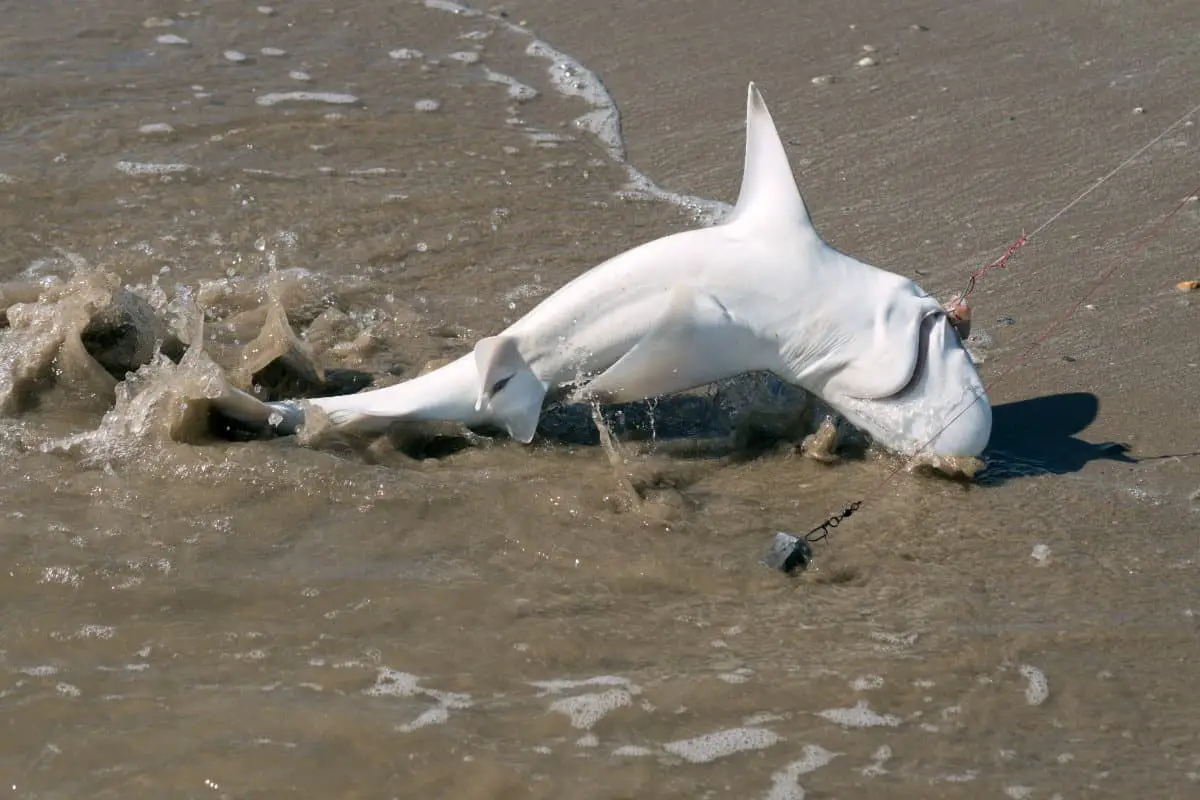Surf fishing is an incredibly fun sport, especially when you try to capture the ocean’s greatest predator: the shark. However, you might be wondering what kind of bait to use to lure in your next big catch. Look no further!
The best shark baits should be fresh and consistent with the marine life the shark would naturally encounter in their environment. The fresher the bait, the more effective. Some of the most popular baits used to catch sharks while surf fishing![]() includes bluefish, little tunny, and ladyfish.
includes bluefish, little tunny, and ladyfish.
Below you will find some general guidelines that will help you determine which bait to use.
General Bait Guidelines
Shark Eating Habits
In general, it has been found that sharks are opportunistic eaters![]() when they reach maturity. This means that they will feast on a wide variety of marine life, including fish, crustaceans, octopus, and even other sharks
when they reach maturity. This means that they will feast on a wide variety of marine life, including fish, crustaceans, octopus, and even other sharks![]() .
.
Although sharks typically eat many species of fish (and, therefore, many types of bait), certain attributes of the bait, such as the freshness, where the bait came from, and the size of the bait you put on the hook are important factors that can influence whether or not the shark decides to bite.
Fresh Bait Is Best
The bait you choose for surf fishing should be as fresh as it possibly can be. When acquiring bait for shark fishing, the general mantra is, “the fresher, the better.”
You may be wondering, “Why can’t I just use frozen fish?” Frozen bait has a weaker scent, and it’s more likely to fall off the hook than fresh bait. Thus, fresh bait has a stronger smell and is more likely to attract sharks.
Where to Get the Bait
The best way to acquire fresh bait is to catch it at the same location where you plan to surf fish for sharks![]() .
.
By catching your bait in the same location, you assure that the bait is fresh, but, more importantly, you’ll know the shark is familiar with the bait, given that he likely eats it on a regular basis.
Victor, from the YouTube Channel Landshark Outdoors![]() , explains why using local fish is so important. In this video
, explains why using local fish is so important. In this video![]() , he discusses sharks’ impressive intelligence and sense of smell. So if you use fish they aren’t familiar with, they’ll know!
, he discusses sharks’ impressive intelligence and sense of smell. So if you use fish they aren’t familiar with, they’ll know!
Video credit: Landshark Outdoors
In fact, their sense of smell is so powerful that it helps them navigate the world![]() ! Each shark nostril can individually detect smells in their environment.
! Each shark nostril can individually detect smells in their environment.
For example, if the shark smells a fish in his left nostril, even a millisecond before he smells it in his right nostril, he will navigate to the left to find his prey.
So, in short, it’s unlikely the shark will eat old or foreign bait. They are simply too smart to be tricked!
But, of course, catching live bait before shark fishing is not always practical. Below I’ve mentioned a couple of other ways you can acquire bait.
One method![]() , recommended by the Hey Skipper
, recommended by the Hey Skipper![]() channel on YouTube, is to catch the bait ahead of time, keep it alive in a bucket, and then bring that bucket to the beach when you go surf fishing.
channel on YouTube, is to catch the bait ahead of time, keep it alive in a bucket, and then bring that bucket to the beach when you go surf fishing.
That way, you have fresh and local fish, but you don’t have to catch them all right before your big fight with the sharks!
Another method is to buy it from a nearby bait shop. Typically, they will have a fresh and local selection of bait for you to choose from.
How Large Should the Bait Be?
Different sharks prefer different sizes of bait, depending on how large they are. If you want to catch a large shark, casting out large bait is probably your best bet.
Try to research the sharks that you will be fishing for to determine what size bait you will need.
However, when in doubt, many anglers![]() find that using baitfish around 8-12 inches (20-30 cm) long typically does the trick.
find that using baitfish around 8-12 inches (20-30 cm) long typically does the trick.
Popular Shark Bait for Surf Fishing
Across the board, sharks prefer fish that have both a high oil and blood content. When selecting your bait, remember the more oil and blood, the better.
Below I’ve listed some of the most popular baitfish among surf fishermen for catching sharks. However, before selecting one of these fish, make sure they are local to your area!
Bluefish
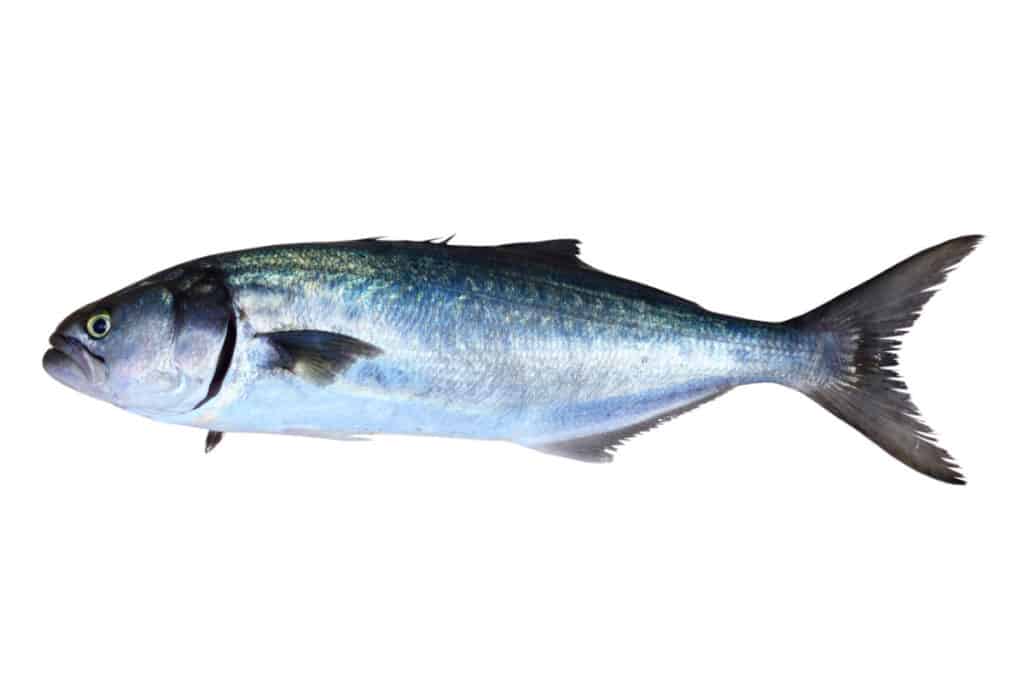
The bluefish![]() is an especially popular shark bait for surf fishing.
is an especially popular shark bait for surf fishing.
They are found throughout the world in temperate coastal regions, except for the eastern Pacific. Bluefish migrate throughout the year, depending on the water temperature![]() .
.
When the water is warmer, bluefish can be found in coastal waters anywhere between
Maine and North Carolina. In the winter, they migrate south and can be found in waters ranging from North Carolina to Florida.
Bluefish are known to be great baitfish because they are oily, easy to catch, and tend to stay on the hook while surf fishing.
Expert shark fisherman, Elliot Sudal![]() , claims that bluefish are especially effective when fishing for sandbar sharks
, claims that bluefish are especially effective when fishing for sandbar sharks![]() .
.
Sandbar sharks roam the Atlantic Ocean as well as the Indo-Pacific.
They are one of the biggest coastal sharks in the world, making them an especially popular catch when surf fishing.
On average, female sandbar sharks can be anywhere from 6.6-8.2 ft (2-2.5 m) long.
Male sandbar sharks tend to be smaller and are about 5.9 ft (1.8 m) long. They can weigh anywhere between 110-150 lbs (50-68 kg).
When using bluefish as bait for the sandbar shark, Sudal suggests that you cut the bait into approximately 10-inch (25.4 cm) strips instead of chunks. He also recommends not skinning the fish.
If you follow these tips, before you know it, that long strip of bluefish will help you reel in the shark of your dreams!
Related post to read:
14 Best Saltwater Baits For Fishing: Complete Guide And Tips on How to Catch Them![]()
Surf Fishing For Bluefish: A Complete Guide
Ladyfish
Ladyfish![]() , also known as Elopidae, are coastal-dwelling fish that are typically found in tropical regions, including the Caribbean Sea and the Gulf of Mexico.
, also known as Elopidae, are coastal-dwelling fish that are typically found in tropical regions, including the Caribbean Sea and the Gulf of Mexico.
However, they occasionally can be found in more temperate regions, including the waters off of Cape Cod.
Ladyfish are slender, usually silver on the sides, with a silvery-green color on their back. They can grow up to 3 ft (0.91 m) long and typically weigh 2-3 lbs (0.91-1.4 kg).
These fish are popular because they are a favorite among sharks. They are also extremely fun to catch![]() ! If you want an exciting “warm-up” before the sharks, try wrestling with a ladyfish.
! If you want an exciting “warm-up” before the sharks, try wrestling with a ladyfish.
They are known for flipping and somersaulting on the hook when caught, so be ready for some action!
Little Tunny, Bonita, or False Albacore
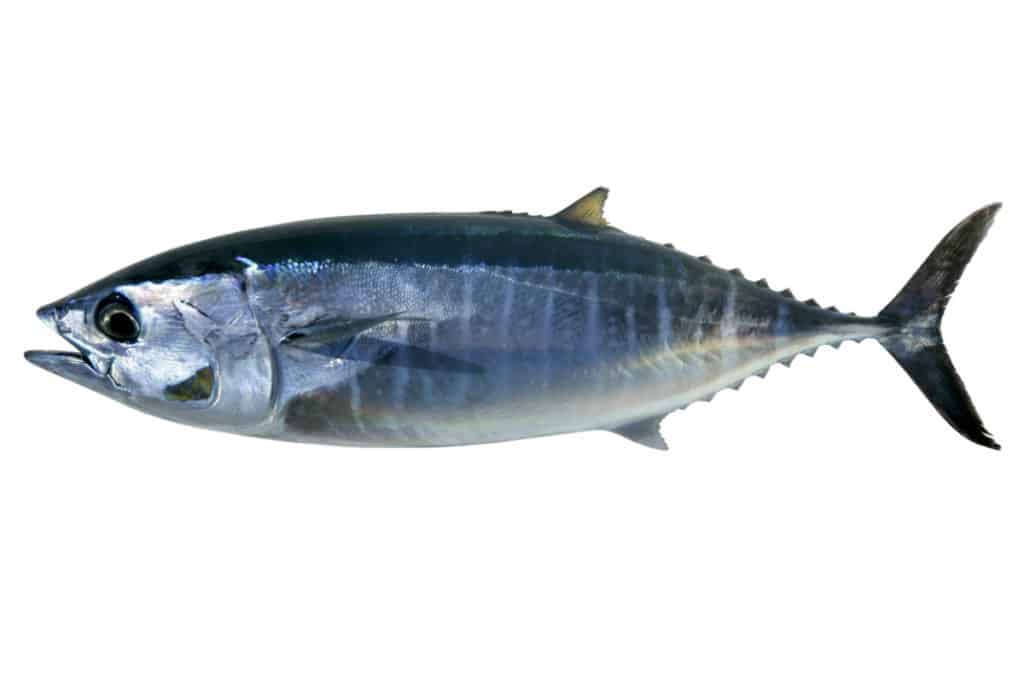
The little tunny![]() , also commonly referred to as the false albacore or the Bonita fish, is the most typical tuna in the Atlantic Ocean. They are also very prevalent in the Mediterranean Sea.
, also commonly referred to as the false albacore or the Bonita fish, is the most typical tuna in the Atlantic Ocean. They are also very prevalent in the Mediterranean Sea.
Little tunny is technically a type of tuna, but they are much smaller than their tuna relatives. The largest recorded little tunny![]() weighed 35.3 lb (16.5 kg) and was 48 inches long (122 cm).
weighed 35.3 lb (16.5 kg) and was 48 inches long (122 cm).
However, on average, a full-grown little tunny typically weighs around 20 lbs (9.1 kg) and is about 32 inches (81 cm) long.
Little tunny is easily identifiable![]() due to wavy markings found on their back and three little “thumbprint” marks that can be seen on either side of their belly.
due to wavy markings found on their back and three little “thumbprint” marks that can be seen on either side of their belly.
Like the bluefish, little tunny is popular bait for sharks due to their high oil content and their good hook retention.
However, they are known for being difficult to catch![]() due to their unpredictable behavior and incredible speed.
due to their unpredictable behavior and incredible speed.
If you want to catch a little tunny for your next shark surf fishing excursion, check out this video![]() by John Skinner Fishing
by John Skinner Fishing![]() . John walks you through the type of lure, tackle, and line; you will need to catch these speedy fish.
. John walks you through the type of lure, tackle, and line; you will need to catch these speedy fish.
Video credit: John Skinner Fishing![]()
After you catch a little tunny, be prepared to use them right away, or quickly put them in the freezer since they become soft very quickly. Even sharks don’t like mushy food!
Mullet
The mullet![]() is a vegetarian fish that lives in tropical and temperate waters. Mullet can be found anywhere from Nova Scotia, Canada, to the Bay of Biscay
is a vegetarian fish that lives in tropical and temperate waters. Mullet can be found anywhere from Nova Scotia, Canada, to the Bay of Biscay![]() near France.
near France.
However, they do not occupy waters near the Bahamas or the Caribbean Sea. Other common names for this fish include flathead grey mullet, black mullet, common mullet, and striped mullet.
The mullet has an olive-green back and silvery sides. Some defining characteristics of the mullet include its two dorsal fins and small triangular mouth.
The largest mullets weigh around 17.6 lbs (8 kg), and they typically range from 20-39 inches (50-100 cm) long.
Mullets are an effective bait for medium-size sharks. The best way to catch them![]() is with a cast net early in the morning.
is with a cast net early in the morning.
These fish are relatively abundant, so depending on where you are fishing, they should be fairly easy to catch.
If catching fresh mullet is not an option, you can typically buy 10-20 lbs (4.5-9 kg) relatively cheaply from a local fish market.
Spanish Mackerel
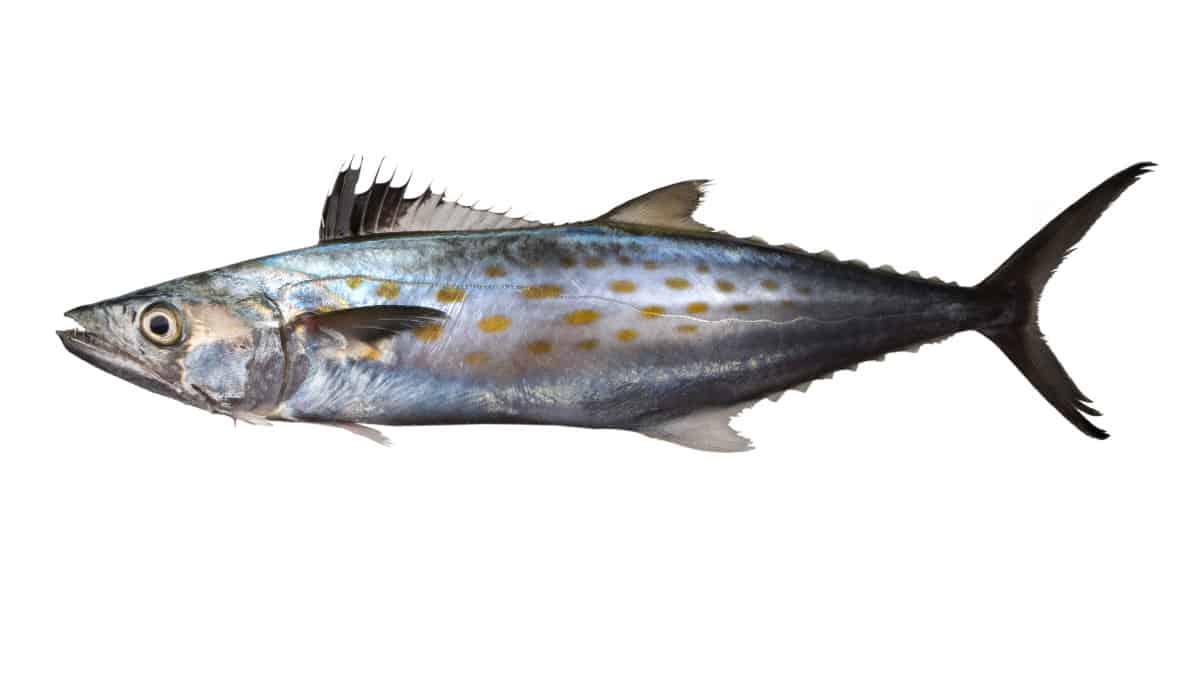
Spanish mackerel![]() is a shallow-water species that typically stays around 10 to 40 ft (3-12 m) deep. They live in the western Atlantic Ocean, migrating up and down the coast, depending on the time of year.
is a shallow-water species that typically stays around 10 to 40 ft (3-12 m) deep. They live in the western Atlantic Ocean, migrating up and down the coast, depending on the time of year.
During the spring, Spanish mackerel swim north, usually reaching the Carolinas by April or May, and the Chesapeake Bay by late-May to early-June.
In the wintertime, they migrate down to Florida, where the water is warmer.
Spanish mackerel commonly reaches about 8-11 lbs (4-5 kg) and is approximately 35.8 inches (91 cm) long.
As far as appearance goes, they are long and sleek with greenbacks and silvery sides that are lined with three rows of small yellow spots.
Spanish mackerel are often caught on the shore and can be used as live bait when shark fishing. To catch a Spanish mackerel![]() , you can use shrimp or strips of mullet as bait.
, you can use shrimp or strips of mullet as bait.
While Spanish mackerel loves to eat shiny fish, such as sardines and herrings, they don’t stay on the hook well, so they are difficult to use when surf fishing.
If you want something that will catch the mackerel and also casts well, shrimp and mullet are the way to go!
Whiting
The whiting fish![]() , officially named the merlangius merlangus, are a type of codfish. When people refer to the whiting fish, they could be referring to one of three species.
, officially named the merlangius merlangus, are a type of codfish. When people refer to the whiting fish, they could be referring to one of three species.
Including the Southern kingfish (most commonly caught throughout Florida), the Gulf kingfish (found along the Texas coast), and the Northern kingcroaker (resides in the western Atlantic Ocean and the Gulf of Mexico).
Like all members of the cod family, the whiting has three distinctive dorsal fins. On average, whiting are 12-14 inches (30.5-35.6 kg) long and weigh 1-2 lbs (0.45-0.91 kg).
However, the largest whiting recorded was 27.5 inches (70 cm) long and a whopping 7 lbs (3.2 kg)!
Whiting can be a variety of colors, including yellow, green, or dark blue. Regardless of their color, all whitings have a distinctive black blotch by their pectoral fin![]() .
.
Unlike some of the other bait contenders on our list, whiting is very easy to catch![]() . They typically hunt for crustaceans in the surf, making them a perfect bait for surf fishing.
. They typically hunt for crustaceans in the surf, making them a perfect bait for surf fishing.
Whitings enjoy eating sand fleas, so if you spot fleas in the sand, whiting fish are likely nearby.
Since whiting enjoys eating sand fleas so much, they are the ideal bait for catching one. However, other bait types are also effective, including live shrimp, cut clams, and oysters!
An ideal whiting bait length ranges from 10-14 inches long, depending on the shark’s size trying to catch.
Crevalle Jacks
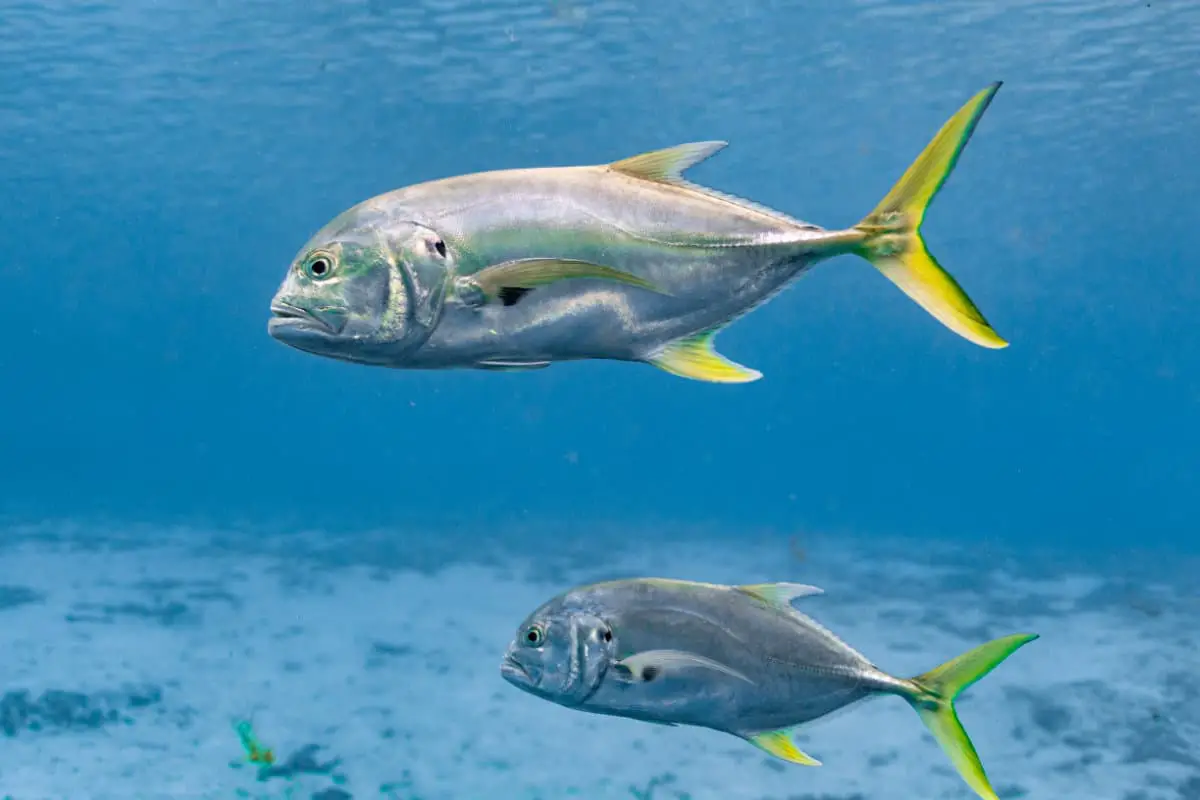
Crevalle jacks![]() are a large fish species with a rounded head with white or grey sides and a bright yellow underbelly.
are a large fish species with a rounded head with white or grey sides and a bright yellow underbelly.
They live in both tropic and temperate waters throughout the eastern and western Atlantic.
They can live anywhere from Nova Scotia, Canada, to Uruguay in the western Atlantic and from Portugal to Angola in the eastern Atlantic.
At their largest, these fish are 49 inches (124 cm) long and can weigh up to 60 lb (27 kg). However, the average crevalle jack is 12-24 inches (30.5-70 cm) long and only weighs 3-5 lbs (1.4-2.3 kg).
Crevalle jacks are known to be powerful and ferocious hunters. Adults prey on a variety of fish and invertebrates![]() , while juveniles eat small fish and crustaceans.
, while juveniles eat small fish and crustaceans.
While crevalle jacks are inedible to humans, they are great bait for sharks since they have very bloody and oily flesh.
The best time to catch crevalle jacks is early in the morning while they are hunting for fish in the surf.
Some effective baits for catching these aggressive predators are menhaden, mullet, and herring.
The jacks that hunt near-shore tend to be on the smaller side, so using bait that is approximately 2-3 inches (5.1-7.6 cm) long should do the trick.
After you get a bite, make sure to reel in fast. Crevalle jacks love to hit fast-moving targets![]() !
!
Menhaden
Menhaden![]() sometimes referred to as pogie, mossbunker, or bunker fish, are flat and oily with forked tails. They are silvery fish with a distinctive black spot behind their gill opening.
sometimes referred to as pogie, mossbunker, or bunker fish, are flat and oily with forked tails. They are silvery fish with a distinctive black spot behind their gill opening.
Menhaden are filter feeders that use their specialized gill rakers![]() to catch plankton. At their largest, they are around 15 inches (38 cm) in length, and they can weigh up to 1 lb (0.45 kg).
to catch plankton. At their largest, they are around 15 inches (38 cm) in length, and they can weigh up to 1 lb (0.45 kg).
The species of menhaden that live in waters off the east coast, known as the Atlantic menhaden![]() , are a very important fish commercially and ecologically
, are a very important fish commercially and ecologically![]() .
.
Commercially, Atlantic menhaden are harvested in great numbers because they are used to make various products, including fertilizers, animal feed, fish oil supplements, and more.
These fish are important ecologically because they provide a link between the plankton they eat and larger predators.
They are eaten by various marine life, including sea birds, marine mammals, and fish (including sharks)!
Menhaden travel in large schools and can primarily be found in waters close to the shore from early spring through early winter.
Menhaden are great for surf fishing because their schools draw predators close to shore.
To catch some Menhaden to use as shark bait, it is recommended that you cast a fast sinking net![]() over the school. After catching the menhaden, cut them into thick chunks. Then, viola! You now have some effective bait.
over the school. After catching the menhaden, cut them into thick chunks. Then, viola! You now have some effective bait.
Conclusion
When surf fishing for sharks![]() , there is a variety of different baitfish you can use. Most of these fish have oily skin and high blood content, making them especially delicious for sharks.
, there is a variety of different baitfish you can use. Most of these fish have oily skin and high blood content, making them especially delicious for sharks.
The most vital thing to remember when selecting bait for shark fishing is that it needs to be fresh and local. Sharks prefer when you use fish that are already part of their regular diet.
The best way to ensure your bait will be effective is to catch it within the same location as your prospective shark.

